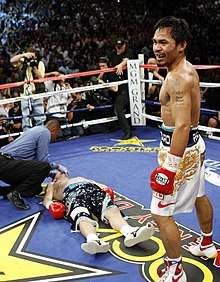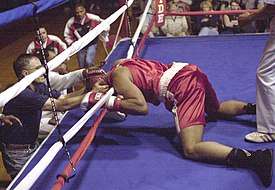Knockout

A knockout (abbreviated to KO or K.O.) is a fight-ending, winning criterion in several full-contact combat sports, such as boxing, kickboxing, muay thai, mixed martial arts, karate, some forms of taekwondo, and other sports involving striking, as well as fighting-based video games. A full knockout is considered any legal strike or combination thereof that renders an opponent unable to continue fighting.
The term is often associated with a sudden traumatic loss of consciousness caused by a physical blow. Single powerful blows to the head (particularly the jawline and temple) can produce a cerebral concussion or a carotid sinus reflex with syncope and cause a sudden, dramatic KO. Body blows, particularly the liver punch, can cause progressive, debilitating pain that can also result in a KO.
In boxing and kickboxing, a knockout is usually awarded when one participant falls to the canvas and is unable to rise to their feet within a specified period of time, typically because of exhaustion, pain, disorientation, or unconsciousness. For example, if a boxer is knocked down and is unable to continue the fight within a ten-second count, they are counted as having been knocked out and their opponent is awarded the KO victory.
In mixed martial arts (MMA) competitions, no time count is given after a knockdown, as the sport allows submission grappling as well as ground and pound. If a fighter loses consciousness ("goes limp") as a result of legal strikes it is declared a KO.[1] Even if the fighter loses consciousness for a brief moment and wakes up again to continue to fight, the fight is stopped and declared a KO.[2] As many MMA fights can take place on the mat rather than standing, it is possible to score a KO via ground and pound, a common victory for grapplers.
In fighting-based video games, such as Street Fighter and Tekken, a player scores a knockout by fully depleting the opponent's health bar, which awards the round to the winning player. The player who wins the most rounds (by scoring the most knockouts or by having more vitality remaining when time expires during each round) wins the match. This is different from real-life combat sports, where a knockout would end the match immediately.
Technical knockout
A technical knockout (TKO or T.K.O.), or stoppage, is declared when the referee or official ring physician decides during a round that a fighter cannot safely continue the match for any reason, without the need for an intervening count. In most regions, a TKO is declared when a fighter is knocked down three times in one round.[3] Other reasons for stopping a fight include severe facial lacerations and a fighter's inability to put up a sufficient defense following a knockdown.
A TKO only occurs if the fight is stopped during a round. If a fighter or his/her cornerman decides to end the fight between rounds, it is ruled a corner retirement or "referee technical decision" (RTD). Both TKO's and corner retirements are counted as knockouts in a fighter's record.
In MMA bouts, the referee may declare a TKO if a fighter cannot intelligently defend him/herself while being repeatedly struck.[1]
Double knockout
A double knockout, in both real life combat sports and fighting-based video games, is when both fighters trade blows and knock each other out simultaneously, and are both unable to continue fighting. In such cases, the match is declared a draw. In fighting games such as Street Fighter and Tekken, a draw is counted as a loss for both players.
Physical characteristics

Little is known about what exactly causes one to be knocked unconscious, but many agree it is related to trauma to the brain stem. This usually happens when the head rotates sharply, often as a result of a strike. There are three general manifestations of such trauma:
- a typical knockout, which results in a sustained (three seconds or more) loss of consciousness (comparable to general anesthesia, when the recipient emerges and has lost memory of the event),
- a "flash" knockout, when a very transient (less than three seconds) loss of consciousness occurs (in the context of a knock-down), and the recipient often maintains awareness and memory of the combat
- a "stunning," a "dazing" or a fighter being "KO'ed on his feet", is when basic consciousness is maintained (and the fighter never leaves their feet) despite a general loss of awareness and extreme distortions in proprioception, balance, visual fields, and auditory processing. Referees are taught specifically to watch for this state, as it cannot be improved by sheer willpower and usually means the fighter is already concussed and unable to safely defend themselves.
A basic principle of boxing and other combat sports is to defend against this vulnerability by keeping both hands raised about the face and the chin tucked in.
A fighter who becomes unconscious from a strike with sufficient knockout power is referred to as having been knocked out or KO'd (kay-ode). Losing balance without losing consciousness is referred to as being knocked down ("down but not out"). Repeated blows to the head, regardless whether they cause loss of consciousness, are known to gradually cause permanent brain damage. In severe cases this may cause strokes or paralysis.[4] This loss of consciousness is commonly known as becoming "punch drunk" or "shot". Because of this, many physicians advise against sports involving knockouts.[5]
Fighters who lose by knockout (either by ten count or technical) are automatically suspended for 30 days, three months if it is the second knockout within three months, or one year if it is the third knockout within one year.[6][7][8]
Knockdown

A knockdown occurs when a fighter touches the floor of the ring with any part of the body other than the feet following a hit, but is able to rise back up and continue fighting. The term is also used if the fighter is hanging on to the ropes, caught between the ropes, or is hanging over the ropes and is unable to fall to the floor and cannot protect himself. A knockdown triggers a count by the referee (normally to 10); if the fighter fails the count, then the fight is ended as a KO.[9]
A flash knockdown is a knockdown where the fighter hits the canvas but recovers quickly enough that a count is not started.[9]
Knockout records
Top 10 boxers by most KOs
- Billy Bird (138)[10]
- Archie Moore (132)
- Young Stribling (129)
- Sam Langford (128)
- Buck Smith (120)
- Kid Azteca (114)
- George Odwell (111)[11]
- Sugar Ray Robinson, Alabama Kid (108)[12]
- Peter Maher (107)
- Sandy Saddler (103)
Top 10 boxing champions (including interims) by KO %
Inactive National Boxing Association, World Colored Boxing Championship as well as list on List of current world boxing champions and European Boxing Union.
- Edwin Valero, Artur Beterbiev, Zhang Junlong, Rostislav Plechko (100%)
- Deontay Wilder (98%)
- Gervonta Davis, Ángel Acosta, Anthony Joshua (95%)
- Jonathan Guzmán (92%)
- Carlos Zarate, Dmitry Kudryashov, Yunier Dorticos, LaMar Clark (90%)
- Rocky Marciano, Wilfredo Gomez, Aaron Pryor, Laila Ali, Gary Mason (88%)
- Vitali Klitschko, Gennady Golovkin, Errol Spence Jr., Naoya Inoue, Jaime Munguia (87%)
- Khaosai Galaxy, Eduard Troyanovsky, Oleksandr Gvozdyk, Gerald McClellan, Miguel Berchelt, In-Chul Baek, David Benavidez (85%)
- Naseem Hamed, Alfonso Zamora, Frank Bruno, David Haye, George Foreman, Alberto Machado (84.0%)
- Srisaket Sor Rungvisai, Daniel Jacobs, Mac Foster (83.0%)
Top 10 MMA fighters by most KOs
- Melvin Manhoef (55)
- Gilbert Yvel (32)
- Igor Vovchanchyn, Alexander Shlemenko (29)
- Wanderlei Silva (27)
- Paul Daley (26)
- Maiquel Falcao, Mirko Filipovic (23)
- Travis Wiuff (22)
- Melvin Guillard (21)
- Paul Buentello, Robbie Lawler, Ben Rothwell, Anderson Silva, Tim Sylvia, Mauricio Rua (20)
Top 10 MMA (Champions, Challengers) Fighters by KO %
Fighters from inactive Pride Fighting Championships and active UFC/Bellator plus champions and former champions from other organizations.
- Conor McGregor (81%)
- Cristiane Justino (76.43%)
- Cain Velasquez (73.3334%)
- Vitor Belfort (72%)
- Cung Le (66.66%)
- Travis Browne (65%)
- Junior dos Santos (64.7%)
- Maiquel Falcao (63.88%)
- Muhammed Lawal, Alexander Volkov (63.64%)
- Holly Holm, Stipe Miocic (60%)
Most consecutive KOs
- Boxing: LaMar Clark (44)[13]
- MMA: Travis Fulton (10)
Most 1st round KOs and most consecutive 1st round KOs
- Boxing: Peter Maher (50)
- Consecutive/Boxing: Ali Raymi (21)
- MMA: Travis Fulton (68)
- Consecutive/MMA: Igor Vovchanchyn, Travis Fulton (7)
Top 10 K-1 and K-2 kickboxers by most KOs
- Changpuek Kiatsongrit (178)
- Badr Hari (92)
- Andy Souwer (87)
- Mike Zambidis (86)
- Branko Cikatic (82)
- Manson Gibson (80)
- Peter Aerts (78)
- Rob Kaman (77)
- Jerome Le Banner (64)
- Ernesto Hoost (62)
See also
References
- 1 2 "Rules and Regulations - Unified Rules and Other MMA Regulations". www.ufc.com. Archived from the original on 2016-04-16.
- ↑ http://mixedmartialarts.com/mma-news/341856/Herb-Dean-The-fight-is-over-when-hes-unconscious%5Bpermanent+dead+link%5D
- ↑ Sugar, Bert. Boxing Archived 2006-06-19 at the Wayback Machine.. www.owingsmillsboxingclub.com. URL last accessed March 4, 2006.
- ↑ "Boxer gets record $22 million settlement from New York in brain injury case". mmafighting.com. Archived from the original on 2017-09-18.
- ↑ Lieberman, Abraham. Causing Parkinson: Boxing, Brain Injury. https://web.archive.org/web/20060422215508/http://www.liebermanparkinsonclinic.com/%27%27. URL last accessed June 24, 2010.
- ↑ Florida Administrative Weekly - Volume 15, Issues 45–52, p. 5233.
- ↑ Official Compilation of the Codes, Rules and Regulations of the State of New York, p. 907.
- ↑ Washington Administrative Code - Volume 1, p. 20.
- 1 2 Boxing Terminology Archived 2012-06-20 at WebCite Ringside by Gus. URL last accessed June 17, 2008.
- ↑ "Billy Bird". Archived from the original on 2015-10-10.
- ↑ "George Odwell". Archived from the original on 2015-10-10.
- ↑ "Alabama Kid". Archived from the original on 2015-10-10.
- ↑ "Boxing by the numbers". Archived from the original on 2012-12-15.
External links
- KO statistics of Mike Tyson, Wladimir Klitschko, Earnie Shavers, George Foreman and other heavyweight boxers
- All famous MMA knockouts
- Knockout Multimedia
- The differences between knockouts and concussions; a simple discussion for beginning boxers
- https://archive.is/20130505222319/http://www.cyberboxingzone.com/cbzforum/showthread.php?1450-Most-Knockouts-Career